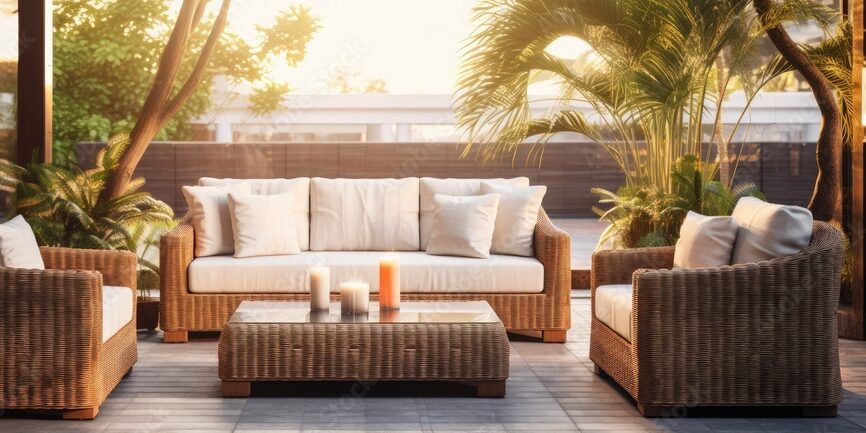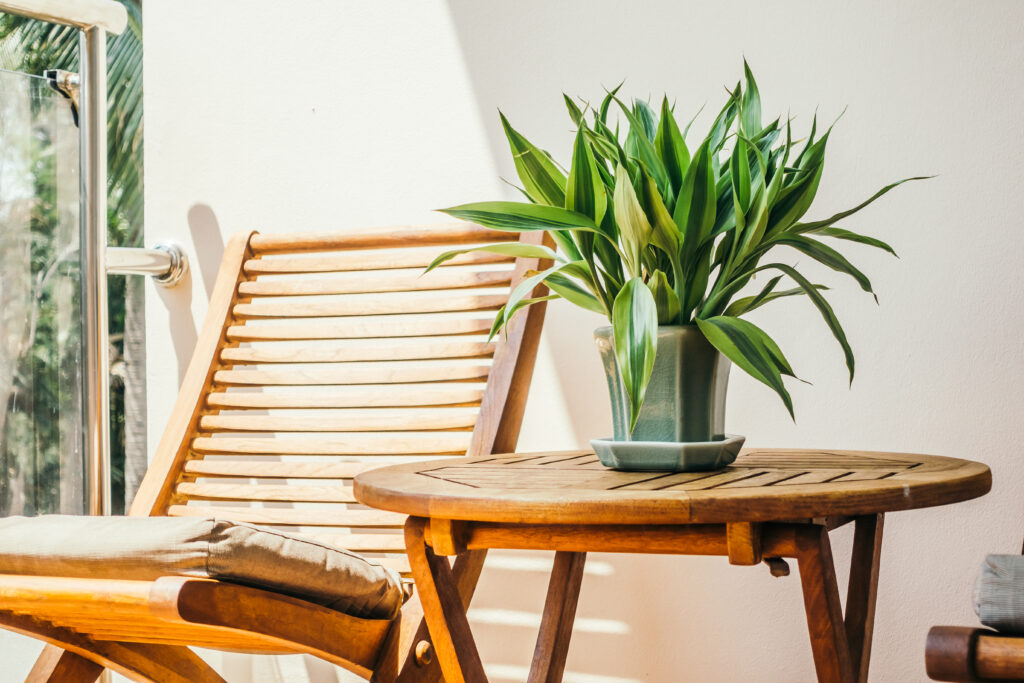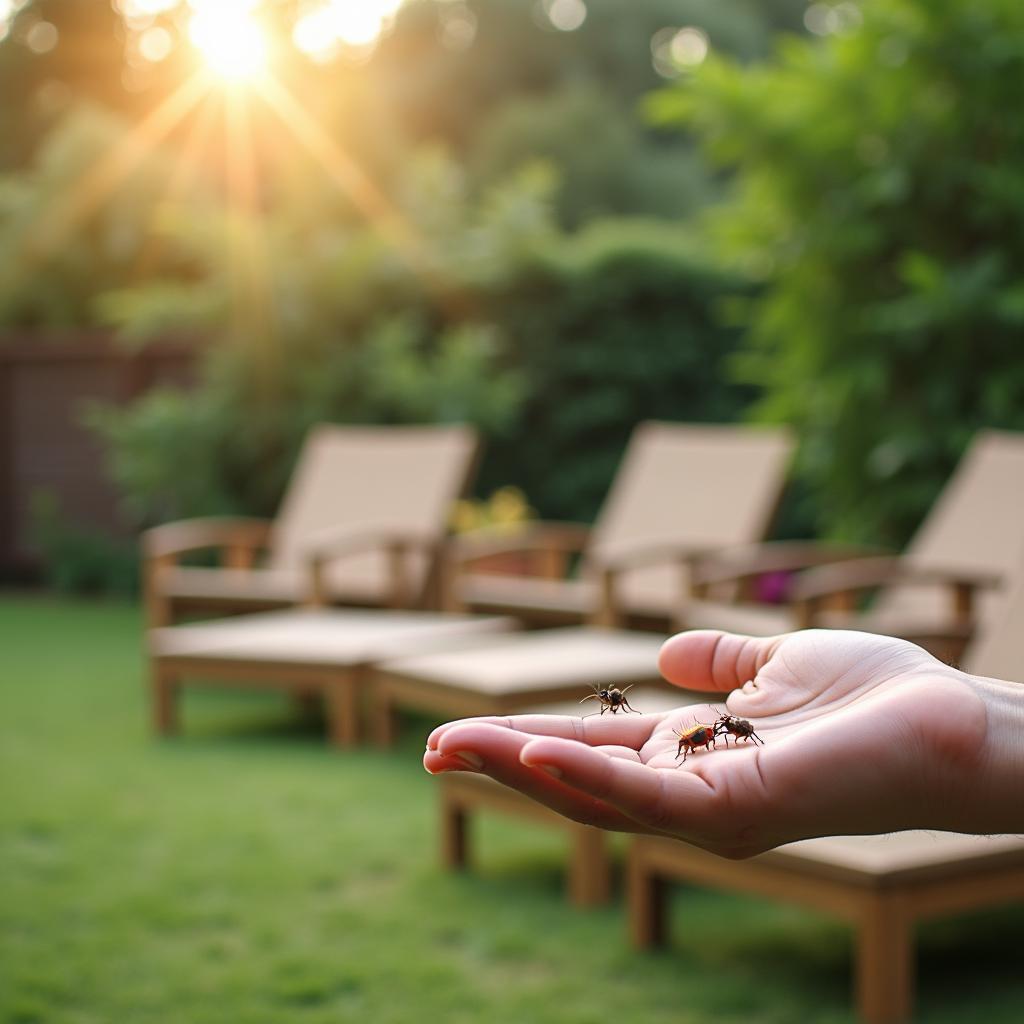As the weather warms up and we start spending more time outdoors, there’s nothing quite like relaxing on your patio furniture. However, uninvited guests in the form of bed bugs and other pests can quickly turn your outdoor oasis into a nightmare. In this comprehensive guide, we’ll explore how to identify, treat, and prevent pest infestations in your outdoor furniture, ensuring your outdoor living space remains a comfortable and bug-free zone.

Understanding the Threat: Common Pests in Outdoor Furniture
Before we dive into prevention and treatment, it’s essential to understand the types of pests that commonly infest outdoor furniture. While bed bugs often come to mind first, several other insects can make your patio their home:
- Bed Bugs: These tiny, reddish-brown insects are notorious for infesting indoor spaces but can also thrive in outdoor furniture.
- Ants: Various ant species can nest in or around outdoor furniture, especially if food crumbs are present.
- Spiders: While most spiders are harmless, some species can be dangerous and may build webs in furniture crevices.
- Mosquitoes: Though they don’t infest furniture directly, mosquitoes are attracted to standing water that may collect on furniture covers or cushions.
- Termites: Wooden outdoor furniture can be susceptible to termite infestations, especially if it’s in contact with the ground.
- Carpet Beetles: These small insects can infest fabric cushions and upholstery, both indoors and outdoors.
- Wasps and Bees: These stinging insects may build nests in or around outdoor furniture.
Knowing which pests you’re dealing with is crucial for effective treatment and prevention.
Signs of Pest Infestation in Outdoor Furniture
Early detection is key to preventing a full-blown infestation. Here are some signs to watch out for:
- Visible Insects: The most obvious sign is seeing the pests themselves on or around your furniture.
- Droppings or Shed Skins: Small dark spots (bed bug feces) or translucent shells (shed exoskeletons) can indicate an infestation.
- Unusual Odors: Some pests, like bed bugs, emit a musty, sweet odor when their populations are large.
- Bite Marks: If you or your family members notice unexplained bite marks after using the furniture, it could be a sign of bed bugs or other biting insects.
- Damage to Furniture: Look for holes in fabric, sawdust-like material (a sign of termites), or weakened wooden structures.
- Stains: Bed bugs can leave small blood stains on fabric when crushed.
- Nests or Webs: Check for insect nests or spider webs in and around your furniture.
Regular inspections of your outdoor furniture can help you catch these signs early and take action before the problem escalates.

Immediate Actions: What to Do If You Find Pests
If you discover pests in your outdoor furniture, don’t panic. Here’s a step-by-step guide to addressing the issue:
- Isolate the Infested Furniture: Move the affected pieces away from other furniture and your home to prevent the infestation from spreading.
- Thoroughly Clean the Furniture: Use hot, soapy water and a stiff brush to clean every surface, paying special attention to crevices and seams where pests might hide.
- Vacuum: Use a powerful vacuum cleaner with a HEPA filter to remove any visible pests, eggs, or debris. Remember to dispose of the vacuum bag in a sealed plastic bag immediately after use.
- Apply Heat or Cold: For items that can withstand extreme temperatures, consider using heat treatment (for bed bugs) or freezing (for various pests) to kill the insects.
- Use Appropriate Pesticides: Choose a pesticide specifically labeled for the pest you’re dealing with and follow the instructions carefully. Always prioritize pet and child-safe options.
- Consider Professional Help: For severe infestations or if you’re dealing with dangerous pests like wasps or certain spiders, it may be best to call a professional pest control service.
- Sun Exposure: If weather permits, leave your furniture in direct sunlight for several hours. The heat and UV rays can help kill some pests and their eggs.
- Repair and Seal: Once the infestation is under control, repair any damage and seal cracks or crevices to prevent future infestations.
Remember, persistence is key. You may need to repeat these steps multiple times to fully eradicate the pests.
Prevention: Keeping Your Outdoor Furniture Pest-Free
An ounce of prevention is worth a pound of cure, especially when it comes to pest control. Here are comprehensive strategies to keep your outdoor furniture pest-free:
Regular Cleaning and Maintenance
- Weekly Cleaning: Make it a habit to clean your outdoor furniture weekly with soap and water. This removes not only dirt but also any pest eggs or small insects that may have recently arrived.
- Cushion Care: Wash removable cushion covers regularly and allow them to dry completely before replacing them.
- Inspect Regularly: Perform thorough inspections of your furniture at least once a month, checking all crevices, seams, and underside areas.
- Prompt Repairs: Fix any damage to your furniture promptly. Cracks, splits, or loose joints can provide perfect hiding spots for pests.
Smart Storage Practices
- Winter Storage: If you live in an area with harsh winters, store your furniture indoors during the off-season. Before storing, clean thoroughly and treat with a preventative pesticide if necessary.
- Use Covers: When furniture is not in use for extended periods, use high-quality, waterproof covers. Ensure the furniture is clean and dry before covering.
- Elevation: Keep wooden furniture slightly elevated off the ground to prevent termite infestations and reduce moisture exposure.
Environmental Control
- Landscape Management: Keep your yard well-maintained. Trim bushes and trees near your patio area, as overgrown vegetation can harbor pests.
- Moisture Control: Ensure proper drainage in your outdoor area to prevent standing water, which attracts mosquitoes and provides a humid environment that many pests love.
- Lighting: Use yellow “bug lights” instead of white lights around your patio area. These are less attractive to flying insects.
- Natural Repellents: Plant pest-repelling plants like lavender, mint, or citronella around your patio area.
Protective Treatments
- Fabric Protection: Treat fabric cushions and upholstery with a fabric protector that includes insect repellent properties.
- Wood Treatments: For wooden furniture, use a sealant or paint that includes insect-repellent properties.
- Preventative Sprays: Periodically apply a pet-safe, outdoor-specific insect repellent around your patio area and on the furniture itself.
Smart Design Choices
- Material Selection: When purchasing new outdoor furniture, consider materials that are naturally pest-resistant, such as teak, cedar, or metal.
- Simplicity in Design: Choose furniture with simple designs and fewer crevices where pests can hide.
- Color Consideration: Lighter colored fabrics make it easier to spot pests and their droppings.
Eco-Friendly Pest Control Methods
For those who prefer natural solutions, there are several eco-friendly methods to control pests on outdoor furniture:
- Diatomaceous Earth: This natural powder can be sprinkled on and around furniture to deter many types of insects.
- Essential Oils: Certain essential oils like peppermint, tea tree, and eucalyptus can repel various pests. Mix with water in a spray bottle and apply to furniture.
- Vinegar Solution: A mixture of equal parts water and white vinegar can be an effective cleaning solution that also deters pests.
- Neem Oil: This natural insecticide can be effective against a wide range of pests and is safe for use around humans and pets when diluted properly.
- Beneficial Insects: Encourage natural predators like ladybugs or praying mantises in your garden to control pest populations.
- Sticky Traps: Use non-toxic sticky traps to catch crawling insects before they reach your furniture.

When to Seek Professional Help
While many pest issues can be handled on your own, there are times when it’s best to call in the professionals:
- Persistent Infestations: If you’ve tried multiple treatment methods and the pests keep returning, it’s time for expert intervention.
- Dangerous Pests: For infestations involving potentially dangerous insects like wasps, hornets, or venomous spiders, always consult professionals.
- Large-Scale Problems: If the infestation has spread beyond your outdoor furniture to other areas of your property, professional treatment may be necessary.
- Time Constraints: If you don’t have the time to dedicate to thorough treatment and prevention, a pest control service can handle it for you.
- Health Concerns: If you or family members have allergies or respiratory issues that might be exacerbated by DIY pest control methods, it’s safer to hire professionals.
Conclusion: Enjoying Your Pest-Free Outdoor Space
Maintaining a pest-free outdoor living area requires vigilance and regular effort, but the rewards are well worth it. By following these prevention tips and addressing any pest issues promptly, you can ensure that your outdoor furniture remains a comfortable, inviting space for relaxation and entertainment.
Remember, the key to effective pest control is a proactive approach. Regular cleaning, smart storage practices, and creating an environment that’s inhospitable to pests will go a long way in keeping your outdoor furniture bug-free.
At UrbanLand Products, we understand the importance of enjoying your outdoor space without the nuisance of pests. That’s why we offer a range of outdoor furniture designed with pest-resistant materials and easy-to-clean surfaces. Visit our website to explore our collection of stylish, durable, and pest-resistant outdoor furniture options that will help you create the perfect bug-free oasis in your backyard.
Don’t let pests ruin your outdoor experience. With the right knowledge, tools, and furniture, you can keep your patio area clean, comfortable, and inviting all season long.
Explore the benefits of outdoor metal furniture, known for its durability and low maintenance. Discover various styles, including modern aluminum, classic wrought iron, and industrial steel, to suit your outdoor space. Learn essential care tips to keep your metal furniture in top shape, such as regular cleaning, rust prevention, and using protective covers during harsh weather.
If you’re looking for high-quality outdoor furniture, UrbanLand Products offers a range of stylish options to enhance your patio or garden. Contact us today to find your perfect outdoor furniture solution!
Frequently Asked Questions: Pests in Outdoor Furniture
- Q: How often should I inspect my outdoor furniture for pests?
- It’s recommended to perform a thorough inspection of your outdoor furniture at least once a month. However, a quick visual check each time you use the furniture can help catch any issues early.
- Q: Can bed bugs survive outdoors in my patio furniture?
- A: Yes, bed bugs can survive outdoors, especially in warmer climates. While they prefer indoor environments, they can infest outdoor furniture, particularly if it’s close to entry points of your home.
- Q: What’s the best way to clean outdoor cushions to prevent pest infestations?
- A: For removable covers, machine wash them in hot water and dry on high heat. For non-removable cushions, use a solution of warm water and mild detergent, scrub thoroughly, and allow to dry completely in direct sunlight.
- Q: Are there any plants I can add to my patio area to naturally repel insects?
- A:Yes, several plants can help repel insects naturally. Some popular options include lavender, citronella grass, marigolds, mint, and rosemary.
- Q: How can I tell if my wooden outdoor furniture has termites?
- Signs of termite infestation in wooden furniture include small holes in the wood, sawdust-like droppings (frass), hollow-sounding wood when tapped, and visible tunnels or galleries in the wood.
- Q: Is it safe to use pesticides on outdoor furniture that pets might come into contact with?
- It’s crucial to use pet-safe pesticides if you have animals. Look for products specifically labeled as safe for pets, and always follow the manufacturer’s instructions. Natural alternatives like diatomaceous earth can also be effective and pet-friendly.
- Q: Can pests in my outdoor furniture spread to inside my house?
- Yes, pests from outdoor furniture can potentially migrate indoors. This is especially true for mobile pests like bed bugs and ants. Regular cleaning and inspection of both outdoor and indoor areas can help prevent this.
- Q: How effective are ultrasonic pest repellers for outdoor use?
- The effectiveness of ultrasonic pest repellers for outdoor use is debated. While some users report success, scientific evidence is limited. They may be worth trying as part of a comprehensive pest control strategy, but shouldn’t be relied upon as a sole solution.
- Q: What should I do if I find a wasp nest in my outdoor furniture?
- If you discover a wasp nest, it’s best to contact a professional pest control service. Attempting to remove it yourself can be dangerous. In the meantime, avoid using the furniture and keep people and pets away from the area.
- Q: How can I protect my outdoor furniture from pests during storage?
- A: Before storage, clean the furniture thoroughly and ensure it’s completely dry. Use airtight covers or wrap larger pieces in plastic sheeting. Adding cedar blocks or lavender sachets can help repel moths and other insects. Store in a cool, dry place off the ground.


